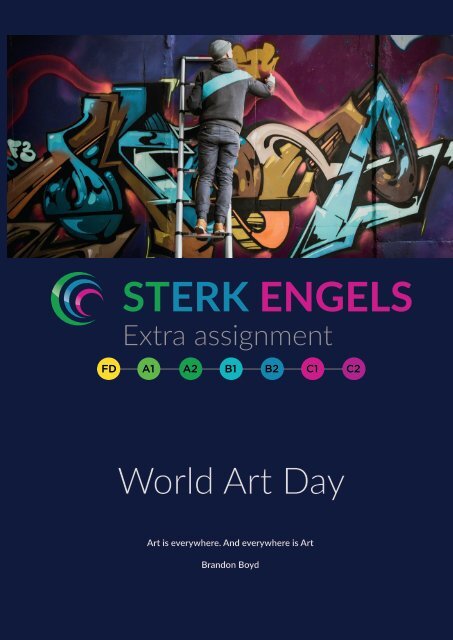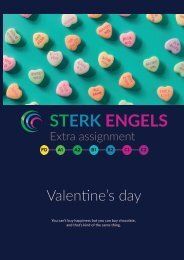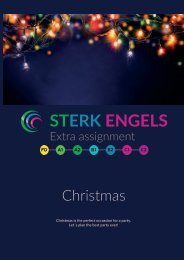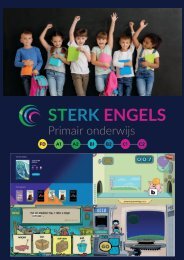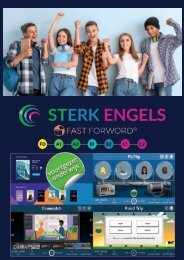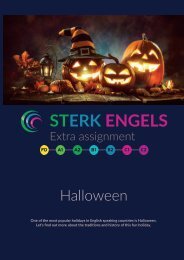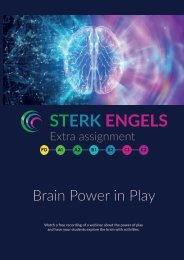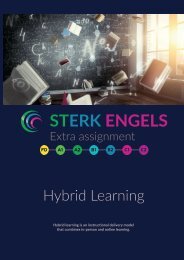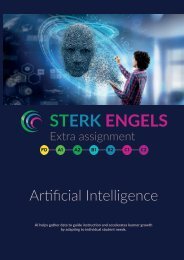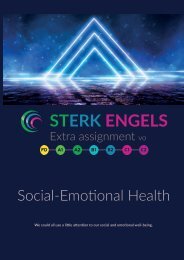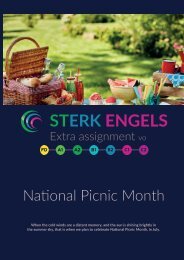World art day
April 15th is World Art day. Art comes in all shapes and sizes, like painting, dancing, literature, digital art, cinematic art, photography, architecture and more. Met STERK Engels gaan jouw leerlingen op een eigentijdse en aansprekende manier aan de slag met de Engelse taal. Het is de enige methode waarin je lezen, uitspraak én tekstbegrip kunt oefenen en meten op ERK-niveau.
April 15th is World Art day. Art comes in all shapes and sizes, like painting, dancing, literature, digital art, cinematic art, photography, architecture and more.
Met STERK Engels gaan jouw leerlingen op een eigentijdse en aansprekende manier aan de slag met de Engelse taal. Het is de enige methode waarin je lezen, uitspraak én tekstbegrip kunt oefenen en meten op ERK-niveau.
Create successful ePaper yourself
Turn your PDF publications into a flip-book with our unique Google optimized e-Paper software.
STERK ENGELS<br />
Extra assignment<br />
FD A1 A2 B1 B2 C1 C2<br />
<strong>World</strong> Art Day<br />
Art is everywhere. And everywhere is Art<br />
Brandon Boyd
<strong>World</strong> Art Day<br />
April 15th is <strong>World</strong> Art <strong>day</strong>. Art comes in all shapes and sizes, like painting, dancing,<br />
literature, digital <strong>art</strong>, cinematic <strong>art</strong>, photography, architecture and more.<br />
In this lesson you will find out more about graffiti. Some people think of it as vandalism,<br />
others call it street <strong>art</strong>. What’s the difference? And how do you feel about it?<br />
Let’s find out.<br />
1<br />
A. Graffiti<br />
Do you know what graffiti is? Do you think it is real <strong>art</strong> or vandalism?<br />
Sort the words into the categories: is it a positive, negative or neutral word?<br />
Look up the meaning of the words if necessary:<br />
events =<br />
gebeurtenissen<br />
beautifying – swear words – the environment – fit in – message – involve –<br />
motivate – preserve – destruction – vandalism – regularly – ordinary –<br />
ridiculous – pointless – provocation – intrigue<br />
POSITIVE NEUTRAL NEGATIVE<br />
beautifying<br />
B. Graffiti - questions<br />
While watching the video a second time,<br />
answer the questions below.<br />
1. Wat vertelt de presentatrice in de eerste 20 seconden van de video?<br />
a. Een beroemde straat<strong>art</strong>iest uit Namibië komt over 10 dagen naar Koeweit.<br />
b. Een straat<strong>art</strong>iest uit Namibië heeft in 10 dagen tijd kunst gemaakt in de<br />
hoofdstad van Koeweit.<br />
c. Een uit Koeweit afkomstige straat<strong>art</strong>iest heeft een 10-daagse reis door Namibië<br />
gemaakt.<br />
2. Wat zijn de redenen dat Mostar de mensen in de omgeving bij zijn kunst betrekt?<br />
Omdat hij niet wil dat het een chaos wordt met allerlei<br />
verschillende soorten graffiti op de muren.<br />
Omdat hij mensen wil inspireren iets moois van de buurt<br />
te maken.<br />
Zodat de mensen met zorg omgaan met het kunstwerk<br />
dat hij maakt.<br />
Om te laten zien wat het verschil is tussen straatkunst en<br />
vandalisme.<br />
WAAR<br />
NIET WAAR<br />
VOOR HET VOORTGEZET ONDERWIJS
C. Graffiti - talk about it<br />
Now talk about the video and the questions:<br />
• Do you think graffiti is <strong>art</strong> or vandalism? Explain.<br />
• Do you like graffiti? Explain why (not).<br />
• Have you ever spray painted? If not, would you like to?<br />
If you did, was it <strong>art</strong> or vandalism?<br />
• Do you feel any different about graffiti after watching the video? Explain.<br />
2<br />
Skim the text<br />
Have a good look at the text. Do not read all of the text, but skim the text first.<br />
What can you tell from skimming the text? You can answer in Dutch:<br />
1. What kind of text is this? This text is...<br />
__________________________________________________________________________<br />
2. What do you think is the topic of the text? The topic of the text is...<br />
__________________________________________________________________________<br />
3. What do you already know about this topic? I already know...<br />
__________________________________________________________________________<br />
Banksy, the most famous anonymous graffiti <strong>art</strong>ist<br />
14 February 2020 Last updated at 18:00<br />
This graffiti by Banksy shows a girl who is letting go of a he<strong>art</strong>-shaped balloon. It is one of Banksy’s most famous works<br />
of <strong>art</strong>. It is a stencilled paining which was originally painted in London on the wall of a printing shop in 2002.<br />
This piece was voted the national favourite work of <strong>art</strong> in 2017.<br />
1) Banksy is one of the most eminent street <strong>art</strong>ists ever. His work pops up all over the<br />
world and is worth millions. But who is this anonymous British <strong>art</strong>ist with his worldwide<br />
fame?<br />
2) The truth is nobody really knows. Even though Banksy is famous all over the world,<br />
his identity is a mystery. Many people have tried to guess who he is, but to this <strong>day</strong> no<br />
one knows for sure who Banksy is. Does he like being anonymous or does he hide his<br />
identity to add to the mystery? Or is it because graffiti is a criminal offence according to<br />
some people? Nobody knows for sure why he doesn’t show his real identity.<br />
VOOR HET VOORTGEZET ONDERWIJS
3) Most of his work can be found in public places, but he usually only takes credit for his<br />
work after he has posted it on his social media. It is easy to spot his work; it is easy to<br />
recognise his style. He uses stencils to create his <strong>art</strong>, probably because it is a very quick<br />
way of painting, which is important to stay anonymous. Banksy was inspired by ‘Blek le<br />
Rat’, a French graffiti <strong>art</strong>ist, who is also said to be the founder of stencilling graffiti.<br />
Some people have a hard time keeping both <strong>art</strong>ists ap<strong>art</strong> from one another: their work<br />
is very much similar.<br />
4) At first, his work just appeared in Bristol. After the turn of the<br />
century his work appeared all over the UK and eventually turned up<br />
all over the world. Much of his work is political: he likes making a<br />
statement about social issues like poverty, the environment and<br />
Brexit.<br />
5) As previously mentioned, Banksy’s work can be worth millions.<br />
So is he in it for the money? Probably not. One of his creations was<br />
sold at an auction for over a million pounds just before it selfdestructed<br />
right in front of a shocked audience.<br />
6) Banksy does not only create street <strong>art</strong>. He is also known to make<br />
drawings, paintings and even installation pieces.<br />
Banksy’s self-destructing<br />
painting which was sold<br />
for over 1M pounds<br />
at an auction<br />
Now answer the questions about the text. Use the dictionary to help you, if necessary.<br />
1. But who is this anonymous… worldwide fame?<br />
Wat betekent deze zin? (alinea 1)<br />
a. Dat Banksy onbekend is en waarschijnlijk honger lijdt.<br />
b. Dat de identiteit van Banksy onbekend is maar zijn werk beroemd.<br />
c. Dat het niet zeker is of het werk van Banksy ook echt door hem is gemaakt.<br />
2. “Even though… a mystery”. Welk van onderstaande woorden kun je het beste<br />
vervangen door het woord ‘mystery’, zoals in deze zin gebruikt? (alinea 2)<br />
a. meester<br />
b. raadsel<br />
c. hysterie<br />
3. Banksy’s werk is makkelijk te herkennen.<br />
De stijl die hij gebruikt is waarschijnlijk te verklaren omdat… (alinea 3)<br />
a. … hij het belangrijk vindt om snel op social media te kunnen posten.<br />
b. … hij zijn identiteit geheim wil houden.<br />
c. … stencils goedkoop en makkelijk zijn.<br />
4. Read the statements below. Are they true or false? (paragraph 4?)<br />
Banksy’s eerste werk verscheen in Bristol.<br />
Een eeuw geleden waren de eerste graffiti kunstwerken te<br />
vinden in Europa.<br />
Veel politici hebben moeite met zijn werk omdat Banksy zich<br />
uitspreekt over de armoede in Engeland.<br />
Banksy maakt graag werken over maatschappelijke thema’s.<br />
TRUE<br />
FALSE<br />
VOOR HET VOORTGEZET ONDERWIJS
3<br />
Let’s talk about it<br />
In class, discuss the assignment.<br />
Challenge: Try to talk in English. Discuss the following questions:<br />
• How do you feel about Banksy and his <strong>art</strong>? Explain.<br />
• Did it help to use a dictionary? Why (not)?<br />
• Do you think Banksy is an <strong>art</strong>ist or a criminal? Explain.<br />
• What do you think is the reason for Banksy to remain anonymous?<br />
Wanneer je werkt<br />
op school met<br />
STERK Engels. Lees dan ook<br />
deze titel met<br />
ClearFluency.<br />
4<br />
A. What is an editorial?<br />
An editorial is a piece of writing to share your opinion. You are going to write an<br />
editorial on graffiti. Watch the video to find out what an editorial is. You can write in<br />
Dutch.<br />
An editorial is:<br />
________________________________________________________________________________<br />
________________________________________________________________________________<br />
________________________________________________________________________________<br />
________________________________________________________________________________<br />
B. Elements of an editorial<br />
You have watched the video about writing an editorial.<br />
Now see if you can explain the meaning of the p<strong>art</strong>s of an editorial.<br />
ELEMENTS OF EDITORIAL<br />
introduction<br />
IN HET NEDERLANDS<br />
strong opinion<br />
cause/problem/effect<br />
other people’s opinion(s)<br />
conclusion<br />
VOOR HET VOORTGEZET ONDERWIJS
5<br />
A. Your own editorial - prepare<br />
Now write your very own editorial<br />
about graffiti. Is it <strong>art</strong> or vandalism?<br />
Watch the video again if necessary.<br />
Answer the questions in one or<br />
two English sentences below.<br />
SENTENCES TO HELP<br />
I just saw a video on YouTube about...<br />
In my opinion...<br />
The problem/cause/effect is...<br />
In short, I think...<br />
Ik zag pas een YouTube video over ...<br />
Ik vind ... /mijn mening is ...<br />
Het probleem/oorzaak/gevolg is ...<br />
Kortom, ik denk ...<br />
1. Introduce the topic.<br />
Wat heeft je er toe gebracht om te<br />
schrijven over dit onderwerp?<br />
__________________________________<br />
__________________________________<br />
2. What is your opinion about<br />
grafitti?<br />
__________________________________<br />
__________________________________<br />
3. What is the problem/cause/effect<br />
of graffiti? Explain your opinion,<br />
using facts, examples etc.<br />
__________________________________<br />
__________________________________<br />
4. What are other people’s opinions?<br />
Explain.<br />
__________________________________<br />
__________________________________<br />
5. What is your conclusion?<br />
__________________________________<br />
__________________________________<br />
__________________________________<br />
__________________________________<br />
B. Your own editorial - write<br />
__________________________________<br />
__________________________________<br />
__________________________________<br />
__________________________________<br />
__________________________________<br />
__________________________________<br />
__________________________________<br />
__________________________________<br />
__________________________________<br />
__________________________________<br />
__________________________________<br />
__________________________________<br />
__________________________________<br />
__________________________________<br />
__________________________________<br />
__________________________________<br />
__________________________________<br />
__________________________________<br />
__________________________________<br />
__________________________________<br />
__________________________________<br />
__________________________________<br />
__________________________________<br />
__________________________________<br />
__________________________________<br />
__________________________________<br />
__________________________________<br />
__________________________________<br />
__________________________________<br />
Your<br />
name<br />
Intro<br />
Strong<br />
opinion<br />
Cause /<br />
problem /<br />
effect<br />
Other<br />
opinions<br />
Conclusion<br />
VOOR HET VOORTGEZET ONDERWIJS
C. Your own editorial - rubric<br />
Now check your own editorial, using the rubric. Work in pairs. check each other’s<br />
editorials and give feedback. Improve your editorial if necessary.<br />
WHAT SCORE POINTS<br />
1. introduction Alle 5 de punten zijn aanwezig en begrijpelijk.<br />
9<br />
2. strong opinion Ten minste 4 punten zijn aanwezig en begrijpelijk. 6<br />
3. problem / cause / Ten minste 3 punten zijn aanwezig en begrijpelijk. 3<br />
effect<br />
Minder dan 2 punten zijn aanwezig en begrijpelijk. 0<br />
4.other people’s<br />
opinion<br />
5. conclusion<br />
Spelling/punctuation Spelling, interpunctie en hoofdletters zijn voldoende. 1<br />
Spelling, interpunctie en hoofdletters zijn<br />
0<br />
onvoldoende.<br />
Grammar<br />
De grammatica is voldoende, fouten verstoren de 2<br />
communicatie niet.<br />
De grammatica is voldoende, fouten verstoren de 1<br />
communicatie soms.<br />
De grammatica is matig, fouten verstoren de<br />
0<br />
communicatie en hoofdletters zijn onvoldoende.<br />
D. Your own editorial - feedback<br />
Now let’s give each other feedback. What went well and what can be improved?<br />
Give each other first a TOP and then a TIP.<br />
My TOPS<br />
My TIPS<br />
E. Your own editorial - rewrite<br />
After checking, rewrite the editorial if necessary.<br />
Use the tops and tips to help you improve your editorial.<br />
VOOR HET VOORTGEZET ONDERWIJS
Antwoorden<br />
1 A.<br />
POSITIVE NEUTRAL NEGATIVE<br />
beautifying message swear words<br />
motivate the environment destruction<br />
preserve involve vandalism<br />
fit in ordinary provocation<br />
Intrigue regularly pointless<br />
ridiculous<br />
B.<br />
1. B<br />
2. B<br />
3. B<br />
4.<br />
Banksy’s eerste werk verscheen in Bristol.<br />
Een eeuw geleden waren de eerste graffiti kunstwerken te<br />
vinden in Europa.<br />
Veel politici hebben moeite met zijn werk omdat Banksy zich<br />
uitspreekt over de armoede in Engeland.<br />
Banksy maakt graag werken over maatschappelijke thema’s.<br />
3 No key<br />
TRUE<br />
x<br />
x<br />
FALSE<br />
x<br />
x<br />
4A. Een soort <strong>art</strong>ikel waarin de editor (redacteur) zijn mening geeft over iets.<br />
B.<br />
ELEMENTS OF EDITORIAL<br />
introduction<br />
strong opinion<br />
cause/problem/effect<br />
other people’s opinion(s)<br />
conclusion<br />
IN HET NEDERLANDS<br />
de inleiding/introductie<br />
duidelijke mening<br />
oorzaak of problem of gevolg<br />
de mening van andere mensen<br />
de conclusie<br />
5 No key. Example:<br />
I just saw a video on YouTube about graffiti <strong>art</strong>.<br />
In my opinion some graffiti is <strong>art</strong>, but some is vandalism.<br />
The problem is that some graffiti does not add anything good or positive<br />
to the environment. Some graffiti is just silly spray paint without any<br />
beauty or message in it. In that case I think graffiti is vandalism, not <strong>art</strong>.<br />
Some people think all graffiti is vandalism. But I feel differently. If graffiti is<br />
in line with its environment and beautifies or enriches it, it can most<br />
certainly be <strong>art</strong>.<br />
In short, graffiti can be vandalism, but it does not have to be. It all depends<br />
on the value it adds to the neighbourhood in my opinion.
Wist je dat …<br />
Wist je dat de lesmethode STERK Engels elk hoofdstuk afsluit met een praktische opdracht<br />
voor zowel spreken als schrijven. Dit om de geleerde stof te verwerken en te laten zien wat de<br />
leerling heeft geleerd.<br />
Meer STERK Engels<br />
STERK Engels Foundations<br />
Voor (speciaal) basisonderwijs.<br />
STERK Engels VMBO<br />
Ervaar de kracht van interactieve instructies en de mogelijkheden van effectieve werkvormen<br />
bij klassikaal werken, afgewisseld met gepersonaliseerd leren.<br />
STERK Engels software<br />
Krachtige aanvulling op uw bestaande Engelse methode voor VMBO MAVO HAVO en VWO.<br />
STERK Engels Basics (Home)<br />
Thuis je Engels verbeteren.<br />
VOOR HET VOORTGEZET ONDERWIJS


